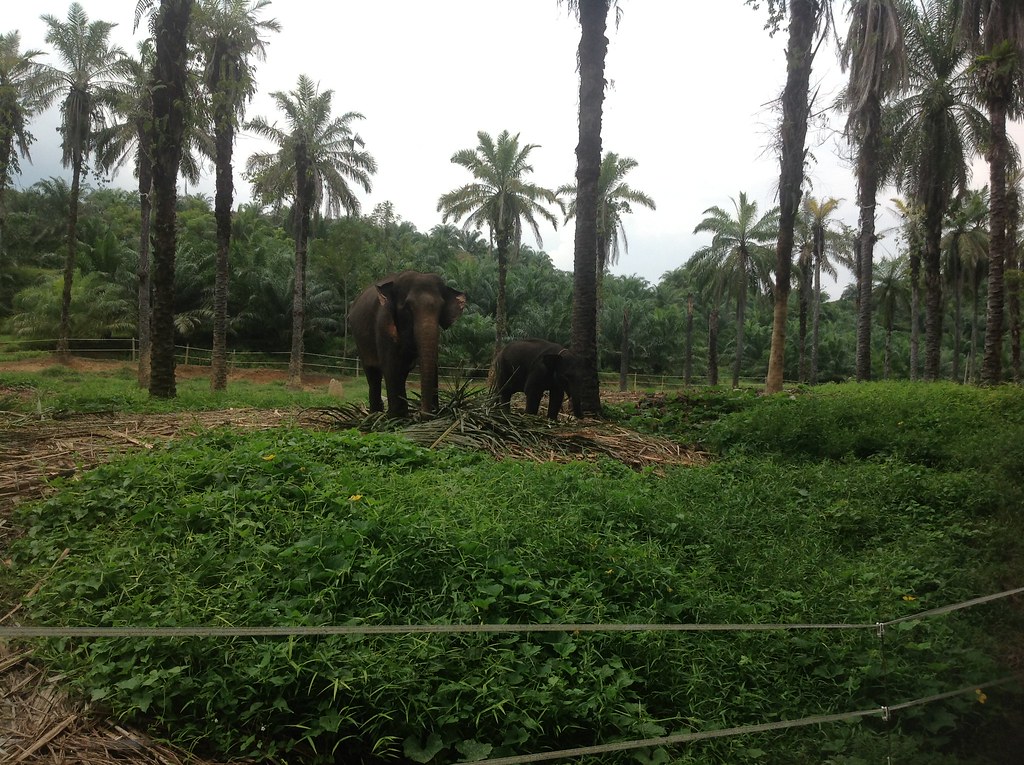
Captive elephants at CRU Tangkahan.
Wild elephants are very large animals, which will inevitably come into conflict with humans in areas of shared habitat. Due to the threat to human life that the elephants pose, problem elephants were likely to be killed. The Indonesian government developed a response to this in the 1980s, which was to capture wild elephants in conflict areas and bring them to elephant training centres.Captured elephants were trained for riding, and some also to work in production forests (for logging). Hundreds of elephants were captured between 1986 and 1999, when the capture program ended (although some wild elephants have since been captured in parts of Sumatra), as the elephants did not generate income for the government, and indeed were expensive to care for and feed. A single captive elephant requires around seven hectares of land, and in many cases the initially protected areas has been reduced in size by plantations and/or logging.
The first elephant training centre, and still the largest, is the Way Kambas Elephant training centre in the far south of Sumatra, which was established in 1985, and aimed to capture all of the wild elephants in the area. Training programmes began with assistance from both Thai mahoots and two trained elephants from Thailand. The system of training starts with a trained elephant, which walks in front, while tied to a wild elephant behind it. Initial work training elephants for logging work proved not to be worthwhile, as there was no demand to employ Sumatran elephants in logging concessions, as they are expensive to feed and care for, and weaker than other Asian elephant species. Elephants from the training centre were sent to Java and Bali to work in tourist parks and zoos.
Another centre was established at Duri, Riau province in 1988, originally on 5000 hectares of land. The elephants here were captured in Riau as well as in Jambi province. Another centre nearby, which is now larger, is at Minas.
Lhokseumawe, in Aceh was also established as a training centre in the late 1980s. However, in around 1999/2000, two mahoots were killed, presumably by Acehnese separatists, and the site was closed down, and the elephants sent to Aras Napal (below), and to Saree, Aceh.
In 1990, the Holiday Resort Aek Raso were established on 4964 hectares of secondary forest at Kota Pinang, Labuhan Batu, North Sumatra, close to the border with Riau province, and a little more than half way between Medan and Pekanbaru, off the main trans-Sumatran highway. Elephants arrived in 1994 to establish an elephant training centre. By 2013 just 30 hectares of land remained, the rest having been illegally planted with rubber and oil palm, and the viability of the project, with 18 elephants, was in question.
In 1994, the Saree elephant training centre was established, in northern Aceh. It is the main elephant training centre in northern Sumatra.
In 1998, five elephants from Way Kambas were sent to Aras Napal, 242 hectares of land previously designated as a mining concession near Bukit Mas village in the Gunung Leuser national park buffer zone, in the Besitang district of Langkat regency, north Sumatra, around 60km north-east of Bukit Lawang. Road access is typically via the main Medan - Binjai - Banda Aceh coastal road. The elephants centre here is not designated a training centre, but rather as 'Elephant Patrol Unit'.
Other elephant training centres in Sumatra are at Seblat, 150km from Bengkulu in south-est Sumatra, established in 1995 on 6900 hectares (in 2014 the government was planning to convert much of the land to oil palm plantation), and at Padang Sugihan in South Sumatra.
Overall the captive elephant programme in Sumatra has declined in scope since 2000, with fewer elephants in captivity, and many of the centres themselves threatened by logging and habitat destruction. Some centres have struggled with medical care or funding, and with training programmes, with untamed elephants a risk to neighbouring human settlements. The elephants are often regarded as primarily an economic asset (which in law belong to the Indonesian government) rather than an animal with rights, and protocols may not meet Western standards, however with wild elephant populations unsustainable without large (250 square kilometre and above) undisturbed areas of land, a life in captivity may be the only alternative to death for elephants in conflict with humans.
In 2001, an ecotourism site, Tangkahan, was established in Namo Sialang, Batang Serangan, Langkat, around 40km north-east of Bukit Lawang. Following the earliest 'Elephant Training Centre', and Aras Napal's 'Elephant Patrol Unit', the new site was designated 'Conservation Response Unit', with elephants transferred from Saree, Aceh to setup the CRU in 2002, with the assistance of Fauna & Flora International.
A CRU uses captive elephants to patrol the jungle in search of illegal activities. In addition, the CRU captive elephants may be used to drive wild elephants away from populated areas, reducing the risk of human death due to wild elephant stampede.
From 2004, the Tangkahan CRU switched the focus of its activities from patrolling the jungle to ecotourism, with elephants working six days a week with tourists, and one day on jungle patrol. Subsequently FFI funding was withdrawn, in 2010, and the site is now self-funding, entirely from tourist income.
CRUs have since been established at Kerinci Seblat (from 2004, and linked to the existing elephant training centre at Kerinci Seblat), in Trumon (from 2012), on the south west coast of Aceh, Cot Girek, near Lhoksemauwe, Aceh, and Leutung, Mane, in Pidie regency of Aceh. Two CRUs were also established in Bungur, and Tegal Yoso, Way Kambas. Unlike Tangkahan, these CRUs are not focused on tourism, but rather on jungle patrol and human-elephant conflict avoidance.